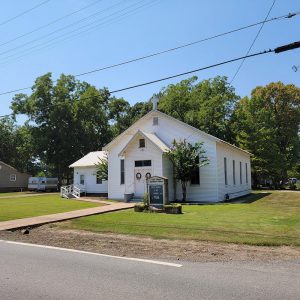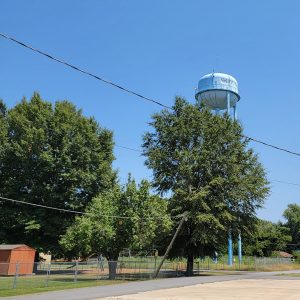calsfoundation@cals.org
Griffithville (White County)
| Latitude and Longitude: | 35°07’25″N 091°38’42″W |
| Elevation: | 217 feet |
| Area: | 0.55 square miles (2020 Census) |
| Population: | 155 (2020 Census) |
| Incorporation Date: | June 1, 1905 |
Historical Population as per the U.S. Census:
|
1810 |
1820 |
1830 |
1840 |
1850 |
1860 |
1870 |
1880 |
1890 |
1900 |
|
– |
– |
– |
– |
– |
– |
– |
– |
– |
– |
|
1910 |
1920 |
1930 |
1940 |
1950 |
1960 |
1970 |
1980 |
1990 |
2000 |
|
202 |
219 |
238 |
244 |
207 |
172 |
227 |
254 |
237 |
262 |
|
2010 |
2020 |
|
|
|
|
|
|
|
|
|
225 |
155 |
|
|
|
|
|
|
|
|
Griffithville is a town in southeastern White County. It is located at the intersection of State Highways 11 and 385.
The first settler in the area that became Griffithville is recorded in census records only as C. Brewer. He owned about 1,500 acres, most of which was forested, but he cultivated about 100 acres and owned about 100 slaves. About a dozen families came from Tennessee in the 1850s to clear land and farm near Brewer’s land. Ten men from the area enlisted at Searcy (White County) in the Confederate army during the Civil War; all ten returned home at the end of the war.
The first school was built in the area around 1867. The teacher was Joshua Pence, and he started with twelve pupils. A Methodist congregation was established in the area in 1878. Egbert Williams opened a general store in 1880. He also ran a post office named Egbert from his store. A second store was opened by A. J. Smith in 1882. Many of the local farmers were members of the Knights of Labor during the 1880s. They also organized chapter No. 137 of the Arkansas State Grange.
In 1898, the Rock Island Railroad built a short line through the area to open the land for the timber industry. Sawmills were built, and a community was planned. The community was named Griffithville after the surveyor of the community, whose last name was Griffith. A post office was established for Griffithville in 1898, and the town incorporated in 1905. A Baptist church was organized in 1898, constructing its first building in 1899. The Methodist church was reestablished in 1900.
The new town of Griffithville soon had five stores and a barber shop. A special school district was established, and a Masonic lodge was chartered. The Ku Klux Klan was also active in the area in the early twentieth century. A bank was chartered in 1905; it was later acquired by First Security Bank before closing. The primary lumber business was construction of railroad ties. Two new sawmills were added in the 1920s. In 1922, a Church of Christ was started, and a Pentecostal congregation began meeting in 1928.
The Depression caused a decline in the timber industry, leading to the closing of the sawmills in Griffithville. Stores closed, and local workers returned to farming, growing both rice and cotton. Six smaller schools were consolidated into Griffithville’s school district, and a new school building was erected by the Works Progress Administration (WPA) in 1939. Following World War II, smaller farming operations were combined into larger farms. Many families left the area to look for jobs in other cities. Improvement of roads allowed some workers to stay in Griffithville, traveling to Searcy or other nearby cities for jobs.
A further wave of consolidation closed the Griffithville school in 1991. Although the school district was combined with those of Judsonia (White County) and Kensett (White County) to form the Riverview School District, children in twenty-first-century Griffithville travel to Des Arc (Prairie County) for their classes.
Businesses in Griffithville include a Riceland Foods regional office, a grain dryer, two stores, the post office, and the bank. Two houses and the WPA school building are on the National Register of Historic Places. The population of Griffithville in 2010 was 225, almost all of whom are white.
For additional information:
Fulbright, Homer. “A Rough Start at Griff in 1932.” White County Heritage 44 (2006): 19–26.
Howerton, Kathleen. “History of Griffithville.” White County Heritage 18 (1980): 55–75.
Steven Teske
Butler Center for Arkansas Studies














Comments
No comments on this entry yet.